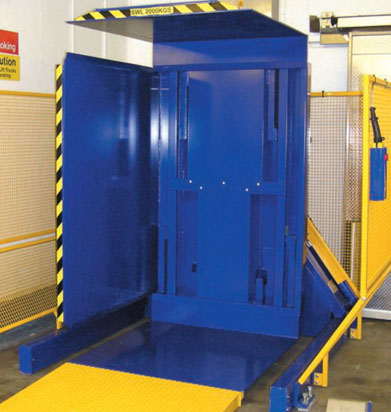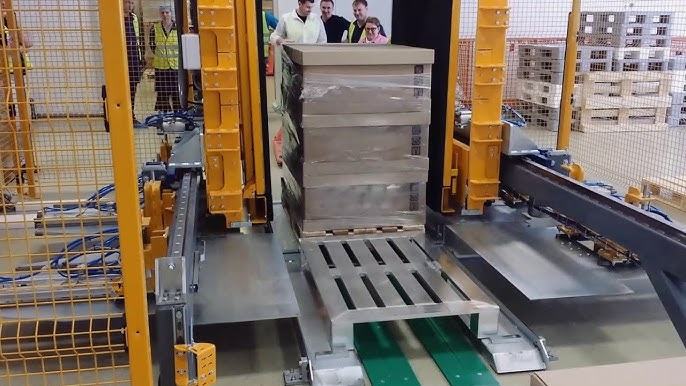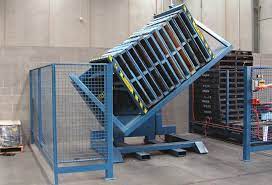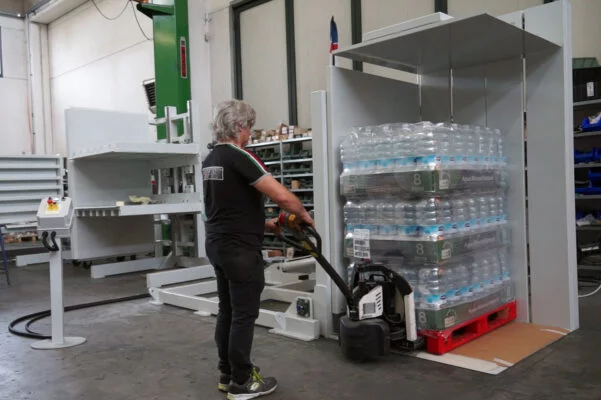Meeting Cold Chain Efficiency And Hygiene Standards Requirements in Turkey with Automated Pallet Exchange
Are your manual pallet handling processes creating bottlenecks in your cold chain logistics? You might be facing product damage, contamination risks, and slow throughput, all of which eat into your profits. In a temperature-controlled environment, every second counts, and outdated methods can lead to significant losses and failure to meet strict hygiene standards, especially in demanding markets like Turkey.
Automated pallet exchange systems solve these problems by providing a fast, hygienic, and efficient method for transferring goods from one pallet to another. These machines minimize manual handling, which drastically reduces the risk of contamination and product damage. They also significantly speed up the transfer process, ensuring that temperature-sensitive products spend minimal time outside of their controlled environment. This directly supports compliance with stringent cold chain and hygiene regulations in Turkey and beyond, while improving overall operational efficiency.

As an engineer and founder of SHJLPACK, I've spent my career solving packaging and handling challenges. While my roots are in steel coil packing, the principles of efficiency, safety, and reliability are universal. A problem in a food processing plant in Turkey and a challenge in a steel mill in Mexico often share the same DNA: the need for smarter material handling. Today, I want to walk you through how automated pallet exchange is not just a solution for one industry, but a fundamental upgrade for any operation looking to improve its logistics. Let's explore how this technology works and how it can be a strategic asset for your business.
How can automated pallet exchangers directly impact your operational costs?
Is your bottom line being squeezed by hidden operational costs? Manual labor for tasks like transferring goods between pallets is often slow, physically demanding, and a major source of unexpected expenses from product damage or workplace injuries. Every time a box is dropped or a worker strains their back, your business pays the price, both directly and indirectly through lower morale and productivity. The solution isn't to work harder; it's to work smarter by automating the process.
An automated pallet exchanger directly reduces operational costs by minimizing labor requirements, preventing product damage, and increasing throughput. These machines can perform the work of multiple employees with greater speed and consistency, freeing up your team for more value-added tasks. By gently handling loads during transfer, they virtually eliminate the costly damage that often occurs with manual or forklift-based methods. This leads to immediate and measurable savings that go straight to your profit margin.

In my years of designing and building machines, I've learned that the biggest cost savings often come from addressing the small, repetitive tasks that drain resources over time. A pallet exchanger is a perfect example of this. It targets a simple but critical process and perfects it. Let's dive deeper into the specific ways this automation translates into financial benefits. We will look beyond the obvious and uncover how a single piece of equipment can create a ripple effect of savings across your entire operation, from the factory floor to your financial statements.
Breaking Down the Cost Savings
When a client considers a new piece of equipment, their first question is always about the return on investment (ROI). For a CEO or a plant owner like Javier Morales, every investment must be justified with hard numbers. Automated pallet exchangers offer one of the clearest paths to ROI in logistics. The savings are not just theoretical; they are tangible and can be calculated.
First, let's talk about labor costs. Manual pallet exchange is incredibly labor-intensive. It often requires two or more workers and a forklift. The process is slow and inefficient. An automated system can be operated by a single person, and in many cases, can be fully integrated into a conveyor line, requiring no direct operator at all. This reallocation of labor means your skilled workers can focus on tasks that require human intelligence and problem-solving, not repetitive manual lifting. For a facility running multiple shifts, the annual savings on labor alone can often justify the machine's cost in less than two years.
Second is the reduction in product damage. This is a huge, often underestimated, cost. When a load is manually de-stacked and re-stacked, or even transferred clumsily with a forklift, the risk of dropping boxes, crushing contents, or contaminating packaging is high. A pallet inverter or exchanger cradles the entire load, gently tilting or pushing it to perform the transfer. I have seen clients reduce their product damage rates from these specific operations by over 90%. In industries like food, beverage, or pharmaceuticals, where a single damaged pallet can be worth thousands of dollars, this is a massive financial win.
Quantifying the Impact
To make this more concrete, let's look at a simple comparison. Imagine a facility that transfers 50 pallets per day.
| Cost Factor | Manual Process (per day) | Automated Process (per day) |
|---|---|---|
| Labor | 2 workers x 4 hours x $25/hr = $200 | 1 operator x 1 hour x $25/hr = $25 |
| Equipment | 1 forklift x 4 hours = dedicated use | Integrated into line = minimal extra equip. |
| Product Damage | ~1% of value ($50 avg.) = $50 | ~0.1% of value ($5 avg.) = $5 |
| Cycle Time | ~10-15 minutes per pallet | ~1-2 minutes per pallet |
| Total Daily Cost | ~$250 + hidden costs | ~$30 + higher throughput |
This table doesn't even include secondary costs like worker compensation claims from injuries, the cost of replacing broken wooden pallets, or the operational drag from a slow-moving logistics chain. When you multiply these daily savings over a year, the numbers become incredibly compelling. This is the kind of strict feasibility analysis that leaders like Javier appreciate. It's not about spending money; it's about investing in a system that pays for itself and continues to generate value for years to come.
What are the key considerations for choosing the right pallet exchange system?
You've seen the potential cost savings, but now you face a new challenge: how do you select the right machine for your specific needs? Choosing the wrong pallet exchanger can be a costly mistake, leading to operational inefficiencies, maintenance headaches, or even a failure to meet critical industry standards like hygiene. It's not a one-size-fits-all solution. A system designed for handling bags of cement is vastly different from one needed for sterile vials in a pharmaceutical plant.
The key to choosing the right pallet exchange system is to conduct a thorough analysis of your product, environment, and operational flow. You must consider factors like load weight and stability, required cycle speed, and the level of hygiene needed. For example, a food processing facility in Turkey would need a stainless steel, wash-down-rated machine, while a standard warehouse might only need a painted steel model. Making the correct choice ensures the machine will be a reliable asset, not a frustrating liability.

I always tell my clients that the machine they choose is a long-term partner in their production line. You need to know what to look for. Just like when you hire a key employee, you need to evaluate their capabilities, their ability to fit into your existing team, and their long-term reliability. Let's break down the critical factors you need to evaluate. This will give you a framework to ask the right questions and ensure you invest in a solution that truly meets your needs, whether you're handling frozen fish in Turkey or steel coils in Mexico.
A Practical Checklist for Equipment Selection
Choosing the right machine is a task I take very seriously. It’s where my engineering background is most valuable to my clients. We are not just selling equipment; we are providing a solution. To do that, we must understand the customer's world. Here are the core factors we analyze with every client.
1. Load Characteristics
This is the starting point. You must define what you are handling.
- Weight and Dimensions: What is the maximum weight? What are the length, width, and height of your typical pallet load? The machine must be rated to handle your heaviest and largest loads safely.
- Load Stability: Are you handling solid boxes, bags, pails, or fragile items like glass bottles? A tipper-style inverter might be perfect for stable loads, but a pusher-style or clamp-and-rotate system might be necessary for unstable or sensitive products.
- Product Type: Is it a food product, a pharmaceutical, or an industrial good? This directly impacts the next point: construction material.
2. Operational Environment and Hygiene
The environment dictates the machine's construction.
- Hygiene Requirements: For food, beverage, and pharmaceutical industries, especially those meeting strict European or Turkish standards, stainless steel construction is often mandatory. Surfaces must be smooth and easy to clean to prevent bacterial growth. A "wash-down" rating means the machine and its electronics can withstand high-pressure cleaning.
- Temperature: In a cold chain application, the machine's components—hydraulics, electronics, and seals—must be rated to perform reliably at low or freezing temperatures.
- Space: How much floor space do you have? Some pallet exchangers have a large footprint, while others are designed to be compact. We always start with a layout drawing to ensure a perfect fit.
3. Performance and Integration
The machine must work seamlessly within your existing workflow.
- Cycle Time: How many pallets per hour do you need to transfer? This will determine whether a simple, standalone machine is sufficient or if you need a high-speed, fully automated inline system.
- Automation Level: Do you want an operator to load the machine with a forklift, or should it receive pallets directly from a conveyor? Full integration with your Warehouse Management System (WMS) or Manufacturing Execution System (MES) is possible and allows for seamless data flow and control. This is a key step towards the digital transformation goals that leaders like Javier are pursuing.
Here is a simplified selection guide to help visualize the process:
| Application | Key Consideration | Recommended Machine Type | Construction |
|---|---|---|---|
| Cold Chain Food (e.g., Turkey) | Hygiene, wash-down | In-line Pallet Exchanger (Pusher or Tipper) | Stainless Steel |
| Pharmaceuticals | cGMP compliance, no contamination | Stainless Steel Pallet Inverter | Stainless Steel |
| General Warehousing | Cost-effectiveness, durability | Freestanding Pallet Inverter (180° Tipper) | Painted Steel |
| Heavy Industrial (e.g., Steel) | High weight capacity, robustness | Heavy-Duty Pallet Tipper or Exchanger | Reinforced Painted Steel |
By carefully working through these points, you move from simply buying a machine to strategically investing in a solution that is perfectly tailored to your operational needs.
How does integrating pallet automation support a company's long-term digital transformation?
Are your factory operations a "black box"? Many established businesses, from steel mills to food processors, run on legacy equipment that provides little to no data, making it difficult to optimize processes. In today's competitive world, this is a significant disadvantage. Digital transformation is not just about having a modern website; it's about making your entire operation visible, measurable, and intelligent.
Integrating automated equipment like a pallet exchanger is a crucial step in this digital journey. These modern machines are built with connectivity in mind. They can be equipped with sensors and controllers that talk to your central systems, like a Manufacturing Execution System (MES). This provides real-time data on throughput, cycle times, and machine status, turning a previously manual, invisible process into a transparent, data-rich node in your production line.

When I started my career as an engineer, machines were just machines. Now, they are data-generating assets. A modern pallet exchanger does more than just move goods; it provides the vital signs of your logistics operation. This data is the fuel for higher-level strategic goals like predictive maintenance and AI-driven production scheduling. Let's explore how a seemingly simple piece of automation can act as a catalyst for a full-scale digital overhaul of your factory floor.
From Mechanical Task to Data Hub
The idea of digital transformation can seem overwhelming. For a practical leader like Javier, it needs to be broken down into manageable, value-driven steps. Integrating a piece of smart automation is one of those steps. It’s a tangible project with a clear outcome that builds momentum for larger initiatives.
1. Creating Production Visibility
The first goal of digitalization is to see what is happening. A pallet exchanger with modern controls and sensors can feed crucial information into your MES or ERP system.
- Pallet Count: You get an accurate, real-time count of pallets processed. This helps verify production numbers and track workflow.
- Cycle Time Data: The system logs how long each transfer takes. If cycle times start to increase, it could be an early indicator of a mechanical issue or an upstream/downstream bottleneck.
- Fault Codes and Alarms: Instead of waiting for an operator to notice a problem, the machine can instantly send an alert to the maintenance team's dashboard or mobile device. This drastically reduces downtime.
This data replaces manual log sheets and guesswork with hard facts, forming the foundation of an intelligent factory. It allows you to manage by exception, focusing your attention where it's needed most.
2. Enabling Predictive Maintenance
One of the biggest challenges for any factory with aging equipment is unplanned downtime. Predictive maintenance, powered by IoT sensors, is the solution.
- Sensor Integration: We can build machines with sensors that monitor motor temperature, hydraulic pressure, and vibration.
- Data Analysis: This data is collected over time. An analytics platform can learn the machine's normal operating signature. When deviations occur—for example, a motor starts to run slightly hotter—the system can flag it for inspection before it fails.
This shifts your maintenance strategy from reactive (fixing what's broken) to proactive (preventing failures). For a goal like achieving 95% equipment uptime, this is not just a nice-to-have; it's essential.
3. Building a Foundation for a Smart Factory
A single automated machine is a start. A network of them creates a smart factory.
| Digital Transformation Stage | Pallet Exchanger's Role | Impact on Operations |
|---|---|---|
| Stage 1: Data Collection | Provides real-time data on throughput and machine health. | Replaces manual tracking with accurate, automated data entry. |
| Stage 2: Process Visualization | Integrates with MES to show pallet transfer status on a factory dashboard. | Managers can see bottlenecks in the logistics flow instantly. |
| Stage 3: Advanced Analytics | Feeds data to platforms for predictive maintenance and efficiency analysis. | Reduces unplanned downtime; identifies opportunities to speed up the line. |
| Stage 4: Full Automation | Receives commands from the WMS to automatically handle incoming pallets. | Creates a fully autonomous "lights-out" logistics operation. |
Each automated system you add, like a pallet exchanger or one of our SHJLPACK coil wrappers, becomes another data point. When connected, they create a complete, dynamic picture of your entire production process, from raw materials to finished goods. This is the ultimate goal of digital transformation, and it begins with smart investments in connected machinery.
What maintenance challenges do pallet exchangers present and how can they be mitigated?
You are considering a new machine, and you know the investment doesn't stop after the purchase. What happens when it breaks down? Aging equipment and rising maintenance costs are a constant headache for any factory owner. The fear that a new, complex machine will become another maintenance burden is a valid concern. If a critical piece of equipment like a pallet exchanger goes down, it can bring your entire shipping or receiving department to a halt.
The key to mitigating maintenance challenges is twofold: choosing a well-designed machine and implementing a robust preventive maintenance program. A machine built with maintenance in mind will have easily accessible components and use standard, readily available parts. A good preventive maintenance schedule, based on the manufacturer's recommendations, helps you replace wear parts before they fail, turning potential emergency shutdowns into planned, brief service intervals.

As an engineer who has designed machines from the ground up, I am passionate about this topic. I believe a great design considers the entire lifecycle of the machine, especially its maintenance. There is nothing more frustrating for a maintenance technician than a component that is impossible to reach. When we design at SHJLPACK, we think about the person who will be servicing that machine five or ten years from now. Let’s look at the common maintenance issues and the practical design and operational strategies to ensure maximum uptime.
Designing for Reliability and Serviceability
A machine's reliability starts on the drawing board. When evaluating a pallet exchanger, you should look for signs of a maintenance-friendly design. This is a core part of the "strategic partner" relationship that a leader like Javier looks for in a supplier. We don't just provide a machine; we provide a reliable production asset.
Common Maintenance Hotspots and Solutions
Every machine with moving parts has components that will eventually wear out. The trick is to manage this wear proactively.
- Hydraulic Systems: Hoses, seals, and pumps are common wear items.
- Design Solution: We use high-quality, brand-name hydraulic components and design layouts where hoses are not overly bent or exposed to damage. We ensure the hydraulic power pack is easily accessible for fluid checks and filter changes.
- Maintenance Strategy: A simple weekly visual inspection for leaks and a scheduled filter and fluid change (typically annually) can prevent most hydraulic failures.
- Electrical Components: Sensors, switches, and wiring can be vulnerable, especially in harsh environments.
- Design Solution: We use industrial-grade sensors with IP67 or higher ratings for wash-down environments. Wiring is run through protected conduits, and control panels are sealed and logically laid out.
- Maintenance Strategy: Regular checks to ensure sensors are clean and aligned, and that all cabinet connections are tight, can prevent intermittent electrical faults.
- Mechanical Wear Parts: Bearings, chains, and clamping pads will wear with use.
- Design Solution: We use oversized bearings and heavy-duty chains for longevity. Clamping surfaces are often fitted with replaceable, durable rubber or polyurethane pads. We design guards and covers to be easily removable for inspection and service.
- Maintenance Strategy: A preventive maintenance kit with these key wear parts should be kept on hand. Scheduled lubrication of bearings and chains is critical.
The Power of a Preventive Maintenance Schedule
A reactive "fix it when it breaks" approach is the most expensive way to maintain equipment. We provide all our clients with a detailed preventive maintenance (PM) schedule.
| Frequency | Task | Purpose |
|---|---|---|
| Daily | Visual inspection of the machine for debris or leaks. Check safety features (light curtains, E-stops). | Ensures safe operation and catches obvious issues early. |
| Weekly | Clean sensors. Check hydraulic fluid level. Check chain tension. | Prevents sensor faults and ensures smooth mechanical operation. |
| Monthly | Lubricate bearings and chains per manufacturer's guide. Inspect hydraulic hoses for wear. | Extends the life of critical moving parts. |
| Annually | Replace hydraulic fluid and filter. Test all electrical connections. A full inspection by a certified technician. | A comprehensive "health check" to prevent major failures. |
By adopting a disciplined PM schedule, you take control of your equipment's health. You maximize uptime, ensure consistent performance, and extend the machine's operational life significantly, delivering on the promise of a stable and reliable production environment.
My Insight
I remember a conversation with a client who runs a large steel processing facility, a man very much like Javier. He visited our factory to see our coil wrapping machines. During the tour, he saw a pallet inverter we had built for a pharmaceutical company. He stopped and watched it for a long time.
He turned to me and said, "Vincent, I handle 20-ton steel coils. That machine handles boxes of pills. What does this have to do with me?"
I explained that the load is different, but the problem is the same: inefficient and unsafe handling. In his plant, they were manually re-stacking smaller bundles of steel wire, a slow and dangerous job. I asked him, "What if we took the principle of that machine—the secure clamping and smooth rotation—and built it to handle your steel wire bundles?"
A light went on in his eyes. He saw past the specific application and understood the core engineering principle. We ended up designing a heavy-duty, customized version of a pallet inverter for him. It completely eliminated the manual handling bottleneck at the end of his line. It reduced a 20-minute, three-person job to a 2-minute, one-person operation.
This experience taught me a powerful lesson: the best solutions often come from looking outside your own industry. The challenges of hygiene in the Turkish cold chain and the challenges of efficiency in a Mexican steel mill can be solved with the same fundamental logic of smart automation. My goal with SHJLPACK is to share these cross-industry insights, helping leaders like you see the universal principles that can drive your business forward.
Conclusion
Ultimately, automated pallet exchange is a strategic investment. It directly boosts efficiency, ensures compliance, and provides the data foundation needed for a modern, competitive operation in any industry.




